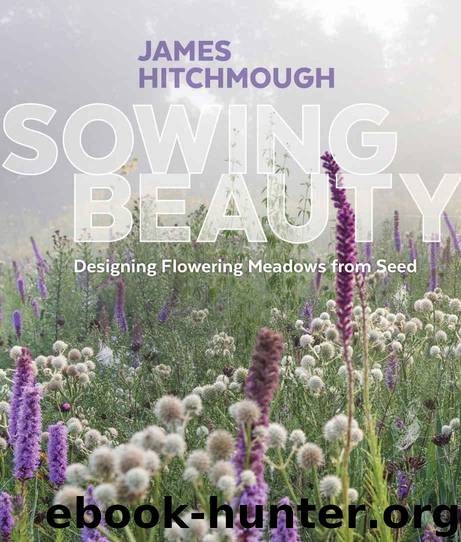Sowing Beauty: Designing Flowering Meadows from Seed by Hitchmough James

Author:Hitchmough, James [Hitchmough, James]
Language: eng
Format: azw3
Publisher: Timber Press
Published: 2017-04-18T16:00:00+00:00
The nature of the site, past management, and existing flora have a major impact on developing the weed control strategy that precedes site development. This area has been long but only occasionally mown, and it contains a mixture of perennial grasses but few really problematic weedy forbs such as creeping thistle and bindweed. The site preparation weed control strategy needs to address what is actually there.
Site preparation
Seedlings cannot generally establish successfully in the presence of adult plants, especially on moderately to highly productive soils. Thus, on sites with an existing herbaceous plant cover, the first activity is to kill this plant cover. Don’t think that this fundamental ecological requirement to reset the site dominance clock is negated by using native species.
We created a range of large-scale native wildflower meadows in a Sheffield park as part of a Ph.D. study. In autumn 2006, an area of mown grass was sprayed by local authority staff with a glyphosate herbicide and then sown with various native wildflower mixes. When we undertook the first assessment in May 2007 the emergence of the sown seed mix was excellent; however, we noted that many of the roots of the perennial grasses (particularly creeping bent grass, Agrostis stolonifera) had not been killed, presumably because the concentration of herbicide used was too low or rain fell soon afterwards, reducing absorption through the leaves. By September 2007, the once promising meadow was a tall lawn of Agrostis, and almost all of the native meadow seedlings had been eliminated by its competition. This is the inevitable outcome on productive soils if you can’t completely kill the original vegetation cover.
The big question is how you eliminate existing vegetation. The answer to this depends on your own philosophical preferences, the legislative framework where the site is, project timescale, the resources available, and the nature of the plant species present that need to be killed. Sometimes in commercial landscape architecture practice there is no existing vegetation to get rid of, because the original soil and its normally weedy flora has long since been stripped off, necessitating a new soil to be imported. I will describe working with the existing soil and plant cover first.
If you have only a very short timescale prior to sowing, say it is June and sowing has to occur by November, the only practical approach that does not involve soil stripping is to spray the vegetation at least twice at 4- to 6-week intervals with a translocated herbicide that contains glyphosate. The actual products differ depending on whether the people applying the herbicide have been professionally trained in how to do this safely and effectively, or whether they are home gardeners who have not. Many readers are likely to see this approach as highly un-ecological, for a variety of philosophical reasons; the irony of using a biocide to create a rich biodiverse habitat is a challenging idea to the ecocentric people who are most likely to be interested in designed naturalistic vegetation in the first place. In some parts of the world, legislation may not permit the use of this otherwise very widely used herbicide.
Download
This site does not store any files on its server. We only index and link to content provided by other sites. Please contact the content providers to delete copyright contents if any and email us, we'll remove relevant links or contents immediately.
| Annuals | Bulbs |
| Flower Arranging | Orchids |
| Perennials | Roses |
Turbulence by E. J. Noyes(7039)
The Thirst by Nesbo Jo(5785)
Gerald's Game by Stephen King(3918)
Be in a Treehouse by Pete Nelson(3212)
Marijuana Grower's Handbook by Ed Rosenthal(3119)
The Sprouting Book by Ann Wigmore(3052)
The Red Files by Lee Winter(2914)
The Remains of the Day by Kazuo Ishiguro(2618)
Sharp Objects: A Novel by Gillian Flynn(2445)
Christian (The Protectors Book 1) by L. Ann Marie(2394)
Organic Mushroom Farming and Mycoremediation by Tradd Cotter(2307)
The Culinary Herbal by Susan Belsinger(2061)
Stone Building by Kevin Gardner(1995)
The Starter Garden Handbook by Alice Mary Alvrez(1925)
Lilac Girls by Martha Hall Kelly(1875)
The Unlikely Pilgrimage of Harold Fry by Rachel Joyce(1836)
The Lean Farm Guide to Growing Vegetables: More In-Depth Lean Techniques for Efficient Organic Production by Ben Hartman(1784)
Urban Farming by Thomas Fox(1749)
Backyard Woodland by Josh VanBrakle(1587)
